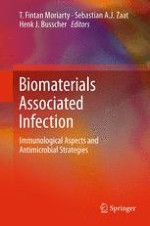2013 | OriginalPaper | Buchkapitel
2. Staphylococcus epidermidis in Biomaterial-Associated Infections
verfasst von : Dietrich Mack, M.D., F.R.C. Path., Angharad P. Davies, Llinos G. Harris, Rose Jeeves, Ben Pascoe, Johannes K.-M. Knobloch, Holger Rohde, Thomas S. Wilkinson
Erschienen in: Biomaterials Associated Infection
Verlag: Springer New York
Aktivieren Sie unsere intelligente Suche, um passende Fachinhalte oder Patente zu finden.
Wählen Sie Textabschnitte aus um mit Künstlicher Intelligenz passenden Patente zu finden. powered by
Markieren Sie Textabschnitte, um KI-gestützt weitere passende Inhalte zu finden. powered by
